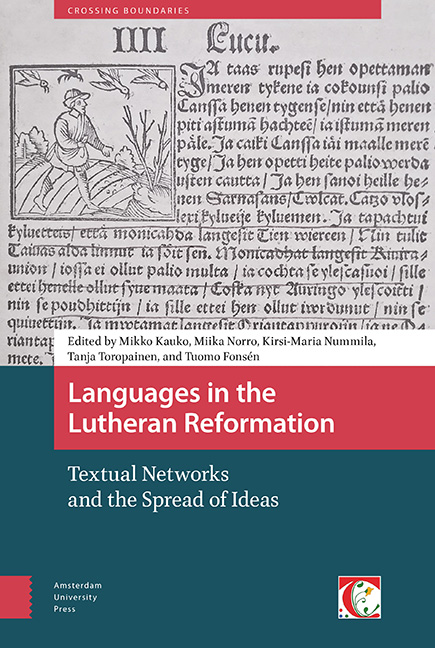Book contents
- Frontmatter
- Contents
- List of Figures and Tables
- Preface
- Introduction
- Part I The Reception of Luther's Ideas and their Influence for the Development of Written Languages
- Part II Effects of Bible Translations on the Evolution of Written Language
- Part III Reuse of (Catholic) Texts after the Reformation
- Part IV Language Contacts and Loanwords
- Index
1 - ‘Quae Pestis Unquam Tam Perniciosa Invasit Gregem Christi?’: The Role of the Book in the Reception of Lutheranism in England
Published online by Cambridge University Press: 21 November 2020
- Frontmatter
- Contents
- List of Figures and Tables
- Preface
- Introduction
- Part I The Reception of Luther's Ideas and their Influence for the Development of Written Languages
- Part II Effects of Bible Translations on the Evolution of Written Language
- Part III Reuse of (Catholic) Texts after the Reformation
- Part IV Language Contacts and Loanwords
- Index
Summary
Abstract
This essay discusses how the ideals of the Lutheran Reformation were received in 16th-century England. Firstly, the essay examines the disagreements between King Henry VIII and Martin Luther regarding the sacraments; secondly, it deals with William Tyndale's English translation of the New Testament (1525, 1526) and how it was received. Tyndale's translation is considered extremely significant for the development of the written English language, and the language itself has been praised as being, among other things, natural, clear, rich, and easily understandable. However, the essay stresses that the merits of Tyndale's work should be seen in the light of Luther's New Testament (1522) and Luther's ideals regarding translation. It is indeed clear that Luther was a model for Tyndale, not only in terms of ideology but also linguistically. English was Tyndale's mother tongue, and written English had long traditions, so the starting point for transmitting Luther's ideas can be considered excellent.
Keywords: Henry VIII, William Tyndale, Martin Luther, Bible translation
Henry VIII and Luther
‘What plague so pernicious did ever invade the Flock of Christ? What Serpent so venomous has crept in, as he who writ of the Babylonian Captivity of the Church?’ – thus (supposedly) the reaction of King Henry VIII on reading Martin Luther's De Captivitate Babylonica Ecclesiae. When on 21 May 1521 Henry responded with his Assertio septem sacramentorum, England – at least in German eyes – emerged from relative obscurity on the edge of Europe to become one of the first powers to oppose Luther's teachings, with Henry championing the old faith against the little Wittenberg professor.
The ‘pernicious plague’ had, of course, been spread by printing, the importance of which the Reformers had soon recognized and embraced. Within a year, Luther's Babylonian Captivity, published at Wittenberg on 6 October 1520, had been disseminated widely throughout Europe. This attack on the Church's teachings on the sacraments was so vehement that Luther later admitted he should have pitied the ‘Papists’ (WA 10, 2: 223). Jean Glapion, Emperor Charles V's confessor, who had originally regarded Luther as ‘a noble new plant from which the Church could harvest useful fruits’, admitted that when he read it he would not have been more shaken if he had been scourged from head to foot (WA 6: 493).
- Type
- Chapter
- Information
- Languages in the Lutheran ReformationTextual Networks and the Spread of Ideas, pp. 33 - 56Publisher: Amsterdam University PressPrint publication year: 2019



